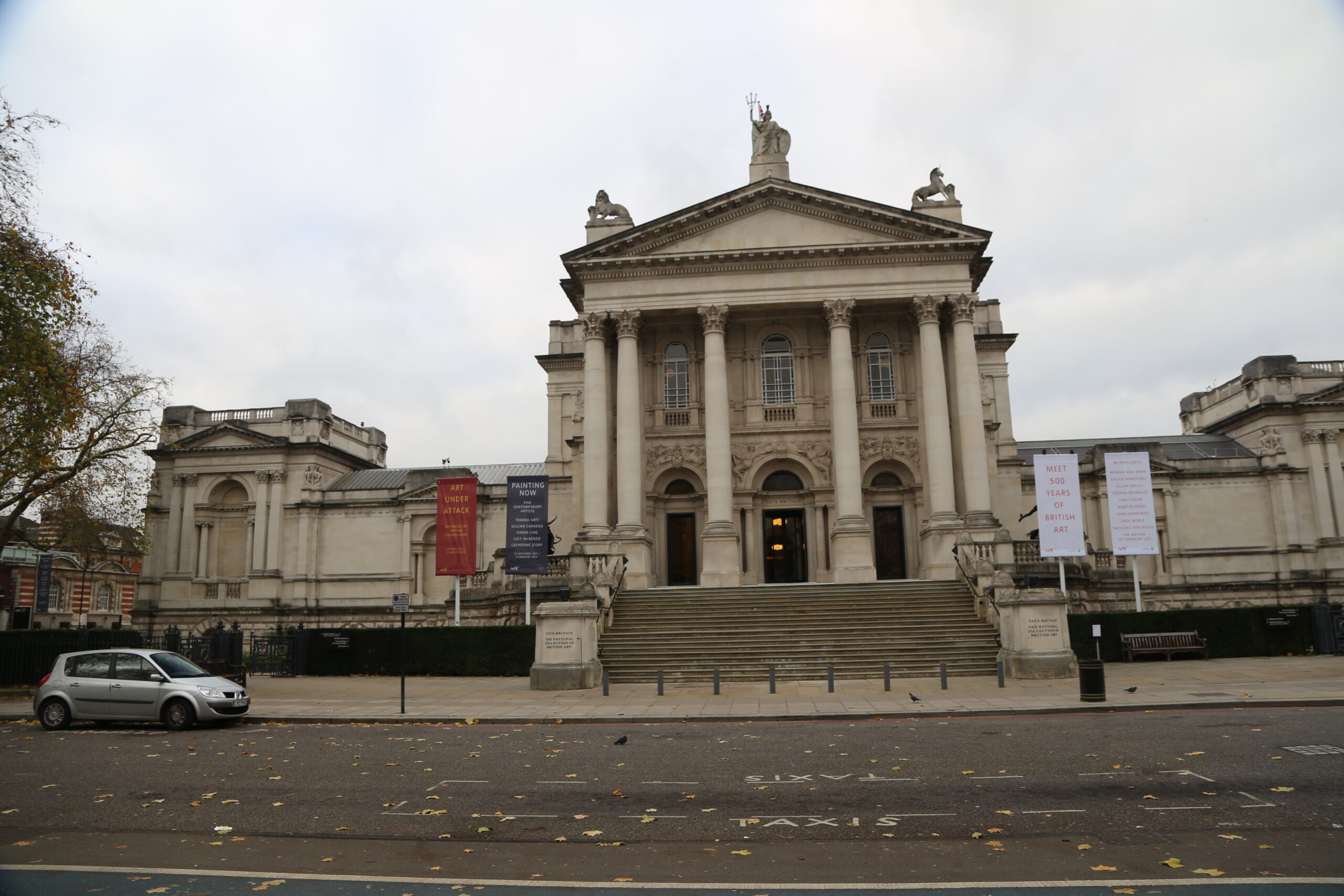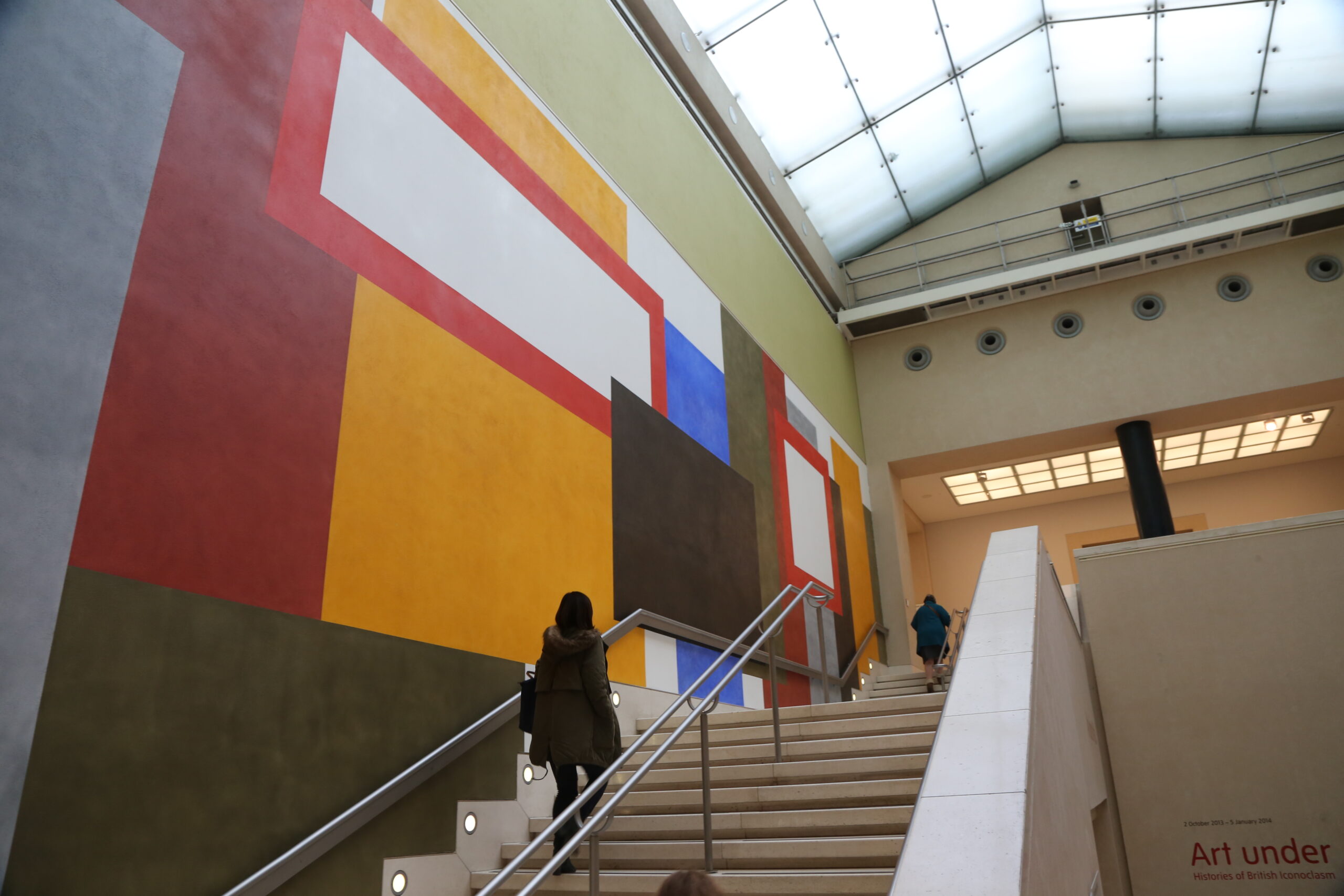This photograph offers a view into one of the grand halls of Tate Britain, a revered institution in London that has carried forward its legacy as a cornerstone of British art. Known historically as the National Gallery of British Art from its inception in 1897 until 1932, and later as the Tate Gallery until the turn of the millennium, Tate Britain is steeped in cultural and artistic significance. Located on Millbank in the heart of the City of Westminster, it is one of the most iconic art museums in England, showcasing a treasure trove of works that narrate the history and evolution of British art.

The hall depicted in the image exemplifies the museum’s architectural magnificence, seamlessly blending its Victorian-era roots with a refined modern gallery sensibility. The barrel-vaulted ceiling, a hallmark of classical design, rises above with luminous skylights that fill the space with diffused daylight, creating an atmosphere of quiet reverence. The elaborate coffering of the ceiling complements the understated elegance of the gray-toned walls, drawing attention to the vibrant paintings that adorn them.
Dominating the gallery are monumental works, such as the dramatic battle scene on the left wall, its vivid colors and animated figures encapsulating the heroism and turbulence of British history. On the right wall, an allegorical tableau unfolds, featuring figures draped in ethereal fabrics that evoke mythological or spiritual themes. These iconic pieces are emblematic of Tate Britain’s dedication to preserving and celebrating works that span centuries of British artistic achievement.
The room’s floor is laid with polished wood, its warm tones harmonizing with the cool, reflective light. A marble bust displayed in the center of the gallery under a protective glass case draws the viewer’s attention as a nod to neoclassical sculpture. Visitors meander through the space, their contemplative movements a testament to the museum’s ability to inspire introspection and engagement. In the distance, the doorway framed by green marble hints at the museum’s vastness, inviting viewers to continue their exploration of British art.
Tate Britain remains a testament to the enduring legacy of the country’s artistic heritage. It is a place where history, culture, and creativity converge, offering both locals and travelers an opportunity to immerse themselves in the profound stories that British art continues to tell. The scene in this photograph captures the spirit of the museum—a harmonious blend of architectural grandeur, historical significance, and timeless artistry.
These photographs collectively capture the grandeur and diversity of Tate Britain, offering glimpses of its exterior, modern design elements, and curated gallery spaces.
The first image portrays the museum’s majestic facade, a neoclassical masterpiece that embodies the architectural heritage of London. The grand staircase, flanked by towering Ionic columns, leads to the main entrance beneath a triangular pediment adorned with sculptural details. The banners hanging on either side advertise current exhibitions, inviting visitors to explore the narratives of British art within. The subdued sky and barren trees framing the scene provide a serene contrast, emphasizing the building’s timeless beauty and its place as a cultural landmark on Millbank.

The second image shifts to a vibrant, contemporary interior space featuring a monumental wall adorned with bold geometric patterns. The composition is dominated by overlapping rectangles in striking colors—red, yellow, blue, and black—juxtaposed against muted olive and gray tones. The clean lines and sharp angles of this artwork infuse the space with modernist energy, demonstrating Tate Britain’s dedication to both historic and avant-garde art. Visitors ascend a sleek staircase beneath a skylight, whose soft light accentuates the interplay of architecture and art. The inscription “Art Under: Histories of British Iconoclasm” hints at the critical dialogue fostered within these walls.

The third photograph returns to the classical galleries, where sculptures and paintings are elegantly displayed. A sleek black sculpture of a child in motion dominates the foreground, its dynamic pose creating a striking focal point. Surrounding the sculpture are a variety of paintings in ornate frames, their themes ranging from mythological to pastoral. The gallery’s high, vaulted ceiling and soft lighting enhance the tranquil ambiance, while visitors meander through the space, absorbed in quiet observation. The view extends through an open doorway, offering a peek into another room and reinforcing the sense of an endless journey through artistic history.

The next photograph offers an intimate view of one of the elegant galleries within Tate Britain, presenting a harmonious interplay between sculpture and painting in a refined, classical setting. The space is dominated by a striking green marble doorway, crowned with gilded accents and inscribed with “The Wolson Gallery,” offering a glimpse into adjacent rooms filled with art, extending the visual narrative beyond the immediate frame.

Central to the composition is a luminous white marble sculpture, possibly a group depicting mythological or allegorical figures, standing gracefully on a pedestal. The figures are entwined, their postures and delicate forms evoking themes of connection and emotion. To the right of this centerpiece, a marble bust stands quietly, exuding an air of contemplation. These sculptural works create a dynamic contrast with the surrounding paintings, which range from dramatic landscapes to serene portraits. Notable is the large painting on the left, bathed in fiery reds and deep shadows, possibly illustrating a moment of great tension or divine intervention, its intense imagery drawing the viewer closer.
The gallery’s warm wooden floor enhances the serene ambiance, with simple benches inviting visitors to linger and absorb the artistic treasures. The muted gray walls, accented by the rich green marble of the doorway and base moldings, provide a neutral canvas that allows the vibrant art to take center stage. Visitors are scattered thoughtfully throughout the room, each engrossed in their own encounter with the artwork, reflecting the museum’s ability to foster deep individual connections with British art.
The photograph encapsulates the essence of Tate Britain as a sanctuary for art, where the careful curation of spaces and the interplay of light, texture, and form create an environment of timeless appreciation and discovery. The green marble doorway, acting as a portal to yet more galleries, emphasizes the endless depth of artistic exploration that the museum has to offer.
Together, these images highlight Tate Britain’s dual commitment to preserving tradition and embracing modernity, making it a space where the past and present meet to inspire contemplation and creativity.
Leave a Reply